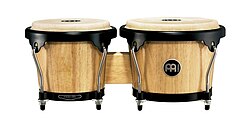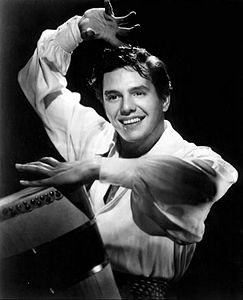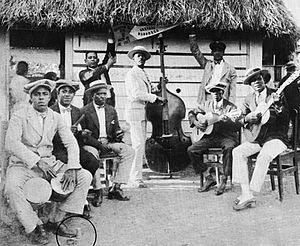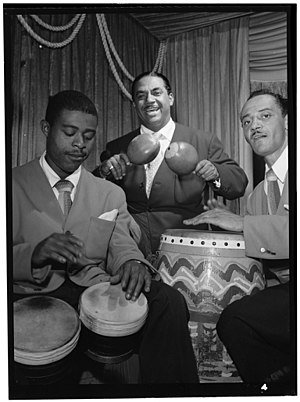Bongo drum
 | |
| Percussion instrument | |
|---|---|
| Other names |
|
| Classification | Percussion |
| Hornbostel–Sachs classification | 211.251.2 (Sets of single-skin conical drums) |
| Developed | Late 19th century in Cuba |
| Related instruments | |
Bongos(Spanish:bongó) are anAfro-Cubanpercussion instrumentconsisting of a pair of small open bottomedhand drumsof different sizes.[1]The pair consists of the largerhembra(lit. 'female') and the smallermacho(lit. 'male'), which are joined by a wooden bridge. They are played with both hands and usually held between the legs, although in some cases, as in classical music, they may be played with sticks or mounted on stands.
Bongos are mainly employed in therhythm sectionofson cubanoandsalsaensembles, often alongside other drums such as the largercongasand the stick-strucktimbales.In these groups, the bongo player is known asbongoseroand often plays a continuous eight-stroke pattern calledmartillo(lit. 'hammer') as well as more rhythmically free parts, providing improvisatory flourishes and rhythmic counterpoint.[2]
Bongos originated in eastern Cuba at the end of the 19th century, possibly from a pair of larger drums such as the bokú. These older, larger bongos are known asbongó del monteand played inchangüí.The smaller bongos used in son cubano were popular across Cuba by the 1910s and reached the concert halls of the eastern United States in the 1930s. By the 1940s, bongos and congas were sharing the stage as son ensembles grew in size and Latin music began to cross-pollinate withjazzand other genres. During the second half of the 20th century, bongos began to be played in a wide variety of genres, frombachatatoLatin rock.[3]
Construction
[edit]Bongo drums are about 20 centimetres (8 in) high and have diameters of approximately 20 centimetres (8 in) and 25 centimetres (10 in).[4][5][6]The shells of the drums and the bridge (the small block that joins them) are usually made of wood, although fiberglass is also common. The heads are typically made ofcalfskinand attached to the shells via steel hardware that enables their tuning (lug tuning). Originally, metal tacks were used, so the skins had to be tightened by heating the skins with a flame and loosened with water or by striking them vigorously.[4][7]This method of tuning is still used for the traditional bongos used in changüí. Therefore, Fernando Ortiz places the original bongó in the category oftambores de candela(flame-tuned drums), along withbokú,yuka,conga,bembéand smaller drums, since these were all tuned with the flame of an oil lamp.[8]
Technique
[edit]
Bongo drums produce relativelyhigh-pitchedsounds compared to conga drums, and should be held behind thekneeswith the larger drum on the right whenright-handed.It is most often played by hand and is especially associated in Cuban music with a steady pattern orostinatoof eighth-notes known as themartillo(hammer).[3]They are traditionally played by striking the edge of the drumheads with the fingers and palms. Theglissandoused withbongó de monte,calledbramido(howl), is done by rubbing the third finger, supported by the thumb, across the head of the drum. Usually, this is done during the climax of a changüí performance.[7]The finger is sometimes moistened with saliva or sweat before rubbing it across the head,[9]but many players use beeswax instead.[7]
When playing son cubano and other popular genres, themachois on the left and thehembraon the right. In changüí, thebongó de monteis positioned the opposite way.[7]Playing patterns are also different in changüí, where thebongódoes not follow a steady beat. Instead, it usually marksoffbeatsand beat four while improvising.[7]Thus, the playing technique in changüí resembles that of the congas (moreover, their pitch is often lower than both bongos and congas).[7]This reflects it origin, since thebongó del monteevolved from pairs ofbokús,a larger drum from eastern Cuba similar to the conga.[7]
Bongos can also be played on a stand, as is the case with concert orchestras and bands. Inclassical musicperformances, bongos are usually struck withmalletsordrumsticks.Examples of pieces featuring bongos includeIonisationby Varèse (1931),Le Marteau sans maîtreby Boulez (1955) andIn seinem Garten liebt Don Perlimplin Belisaby Fortner (1962).[10]Steve Reich's 1971 pieceDrummingfeatures four pairs of carefully tuned bongos played with drumsticks.[11]
History
[edit]Origin and etymology
[edit]
The origin of the bongo is largely unclear. Its use was first documented in the eastern region of Cuba, theOriente Province,during the late 19th century, where it was employed in music styles such asnengón,changüí,and their descendant, theson cubano.[3]According toFernando Ortiz,the wordbongóderived from theBantuwordsmgomboorngoma,meaning drum.[12]He hypothesizes that the word evolved throughmetathesisand by similarity with another Bantu word,mbongo.[12]According to Ortiz's early 20th century informants, the largebongó del monte(mountain bongo) used in changüí was the ancestor of the smaller bongó used in son cubano and salsa.[7]
As explained by eastern Cuban informants to Benjamin Lapidus, the oral tradition among changüí musicians in Oriente is that thebongóoriginated as a replacement for pairs of bokús that were slung over the player's knee.[7]Bokús are tall drums popular in the eastern provinces, particularly during carnival processions, and featured in early changüí groups. Eventually, these drums were cut in half into bongos. This may explain why thebongó del monteused in changüí is larger than the bongos used in son. InHolguín,similar drums which are considered possible ancestors of thebongóare known astahona,which might have a been a generic word for drum in Cuba and also refers to anunrelated music genre.[13]Other generic terms that have been used to refer to bongos across eastern Cuba include tahonitas, tambora, atambora and tumba.[14]
The bokú/tahona origin of the bongos agrees with the generally agreed notion held by Afro-Cuban cultural historians that the bongo derives fromBantudrum models from Central Africa, noticeable in the open bottoms. The strong historical presence of Africans from theCongo/Angola regionin eastern Cuba (where the bongo first appeared) makes such an influence possible, as does the widespread use of the term bongó/bonkó among Bantu speakers.[7]Moreover, Central African/Congo influences are also documented in both son cubano and changüí, and initially the development of the bongo drum was in parallel with these genres. From such conceptual African drum models, the bongo developed further in Cuba itself, and some historians state that the attaching of the two drums was a later invention that took place in Cuba. Therefore, the instrument has been described as "African in concept but Cuban in invention".[15]Ortiz's hypothesis for the origin of the bokú is that their tall unusual shape was the result of a purposeful avoidance of "African-looking" drums by Afro-Cuban musicians at a time when most drums of that sort were banned.[16]
Less supported hypotheses for the origin of the bongos, largely based on their superficial similarity to other twin drums, include the Cuban pailas andtimbales(descended from European tympani), the Arabnakers,the North Africantbilat(called "African clay bongos" ),[17]the Indiantabla,etc.[18][19]
Evolution and popularization
[edit]
The bongo entered Cuban popular music as a key instrument of early son ensembles, quickly becoming—due to the increasing popularity of the son— "the first instrument with an undeniable African past to be accepted in Cuban “society” circles ".[3]This is attested, for example, in poems byNicolás Guillén.[3]As son evolved and distanced itself from its precursor, the changüí, so did the bongos. The bongos used in changüí, known asbongó de monte,are larger and tuned lower than their modern counterparts, have tack-heads instead of tunable hardware, and play in a manner similar to the lead conga drum (quinto) and other folkloric lead drum parts.[7]Unlike modern son, changüí never extended its popularity beyond eastern Cuba, and hence its bongos remain a rare sight. It is commonly accepted that the son reached Havana partly as a result of the arrival of musicians members of Cuba'sejército permanente(permanent army), which brought music from eastern Cuba with them. Among the first knownbongoserosto enlist in theejército permanenteinSantiago de Cubawas Mariano Mena.[20]
During thesextetoera, son groups began performing and touring more than ever before, and for the first time, recordings were being made. It was in this context that the first great innovators of the bongo made their mark, and unlike their predecessors, their names were not lost in time.[3]Of particular note were Óscar Sotolongo of theSexteto Habaneroand José Manuel Carriera Incharte "El Chino" of theSexteto Nacional,the two leading groups of the 1920s and '30s. Sotolongo himself would later leave the Habanero and direct his own group, the Conjunto Típico Cubano.[21]His replacement was Agustín Gutiérrez "Manana", who is widely considered one of the most influentialbongoseros,partly due to his condition as anAbakuámember, which allowed him to develop techniques based on the ekué (secret drum) drumming of such society.[15]In 1930, Sotolongo's son, Andrés Sotolongo replaced Gutiérrez in the Habanero.[22]Decades later, at 82 years of age, Andrés Sotolongo was recorded for theRoutes of Rhythmdocumentary playing alongsideIsaac Oviedo.[23]
"The Cuban government has prohibited the beating of the African bongo drum. The restriction carries heavy penalties on the ground that the monotonous reverberations induce a state of savagery in ignorant listeners and a state of irritation in others."
In 1929, bongos and other drums were banned by the Cuban government.[24][25]This prohibition extended that of 1925, which outlawed congas in the context of street carnivals, but not the comparsas themselves. Ironically, this original ban was enacted by the mayor of Santiago de Cuba,Desiderio Arnaz II,father ofDesi Arnaz,who later popularized congas, bongos and bokús across America and the world. This repression of Afro-Cuban culture was denounced by poets in theAfrocubanismosuch as Guillén, whose "Canción del bongó" (Song of the bongo) was published in 1931.[26]
The 1930s saw an increase in the technical skill ofbongoseros,as evidenced by Clemente "Chicho" Piquero, whose virtuosic performances inspired a youngMongo Santamaríato take up the instrument.[27][note 1]By the early 1940s, Santamaría had become a master of the instrument, performing with theLecuona Cuban Boys,Sonora Matancera,Conjunto MatamorosandArsenio Rodríguez's "Conjunto Segundo" among others.[27]Arsenio had pioneered theconjuntoformat by incorporating atumbadora(conga drum) into the rhythm section and having thebongoserodouble on cowbell. Arsenio's long-timebongoserowas Antolín "Papa Kila" Suárez, who is often cited as one of the greatest of his time along with Pedro Mena of the Conjunto Matamoros.[30]Arsenio's group also helped break the barriers of race, which particularly affectedbongoseros.For example, theOrquesta Casino de la Playadid not allow their blackbongoseroRamón Castro to perform on stage, nor was Arsenio allowed on the tres.[31]The Casino de la Playa would also featurebongoseroCándido Requena, who later joined the Conjunto Kubavana and Conjunto Niágara, and became one of Cuba's foremost makers of bongos andtumbadoras.[32]Requena, as well as the Vergara brothers, were instrumental in the technological improvement of bongos and congas.[33]Before the advent of mechanically tunable bongos and congas in the 1940s, both instruments used to be tuned withoilorkerosene lamps.The heat of the flame was used to contract thedrumheadto achieve the desired sound.[33]
Following the popularization of thetumbadora,Santamaría switched to the instrument, while remaining a close friend ofbongoseroArmando Peraza.[34]Both moved toNew Yorkby 1950, bringing their music abilities with them. Among thebongoseroswho stayed in Cuba were the aforementioned Chicho Piquero, who had become a close friend ofBenny Moréin Mexico and became his Banda Gigante'sbongoseroback in Cuba. Also important during the 1950s were Papa Gofio of the Conjunto Rumbavana and Rogelio "Yeyo" Iglesias, the main bongo player in Havana'sdescargascene.[35]Over the course of the 20th century, the bongo spread throughout Latin America. In the Dominican Republic, the bongo became integral tobachata,a genre related tobolerothat emerged in the 1960s.[36]
In the United States
[edit]
In the 1920s, bongos were first played in the United States during the recording sessions of Cuban son ensembles such asSexteto Nacional,which recorded inNew York CityforColumbia Records.Among the tracks recorded in their 1927 sessions was "Viva el bongó",[37]a song about the instrument itself which—unlike the stylized Cuban son popular at the time—brought percussion to the foreground.[38]Since these recordings were mainly sold in Cuba, they did not have any cultural impact in the US.
Things changed one Saturday afternoon in April 1930, when the Havana Casino Orchestra directed byDon Azpiazúdebuted their live show at thePalace Theatrein New York. Featuring José "Chiquito" Socarrás on bongos, Don Azpiazú's successful performances and recordings of "El manisero"gave rise to a dance craze known as"rhumba"(in reality based on Cuban son) which led to the widespread use of the bongo among Latin bands in New York.[39]In the early 1930s, Cuban orchestras proliferated in New York, featuring the bongo as key percussion instrument, including those directed by Antonio Machín, Alberto Socarrás, Pedro Vía, Antobal, Enrique Bryon, etc. However, apart from Chiquito Socarrás, who was also a singer, there were nobongoserosof renown and the instrument did not yet permeate American music styles.
Spearheaded by the iconiccongueroChano Pozo,the late 1940s saw an exodus of Afro-Cuban percussionists from Cuba to the United States. Among the leadingbongoserosof Cuban origin in the United States wereArmando Peraza,Chino Pozo(unrelated to Chano) andRogelio Darias,who had a long career inLas Vegasand was known as the King of the Bongo.[40]Many others, however, would become primarily conga players, such asMongo Santamaría,Sabú MartínezandCándido Camero.
The Latin music scene of New York, and the US in general, was primarily constituted by Puerto Ricans, and many influentialbongoseroswere Puerto Ricans who learned from Cubans. An early example is Rafael "Congo" Castro, who arrived in New York in 1924 and had a long career as abongoseroin Chicago until the 1980s.[41]In New York, many Puerto Ricanbongoseroswould go on to join the pioneeringAfro-Cuban jazzensembles of the time such asMachitoand his Afro-Cubans, whose singles "Tangá" and "Mango mangüé" —considered the first examples of the genre—featuredJosé Mangual Sr. "Buyú"on bongos.Mangual'sprolific career was continued by his sonsJosé Mangual Jr.and Luis Mangual, who played in a variety ofsalsagroups in the 1970s. The two biggest Latin orchestras of the 1950s in New York, led byTito PuenteandTito Rodríguez,were home to two generations ofbongoserosrepresented by Johnny "La Vaca" Rodríguez and his sonJohnny "Dandy" Rodríguez,of Puerto Rican ancestry.[42]
Other Puerto Rican musicians who made a name for themselves on the bongos were Richie Bastar ofEl Gran Combo de Puerto Rico,Ralph Marzán ofJohnny Pacheco's charanga, "Little" Ray Romero,Frank ColónandRoberto Roena.On the other hand, American masterbongoserosincludeJack CostanzoandWillie Bobo(of Puerto Rican origin), the latter more active ontimbales.Otherbongoseroswho had more impact astimbaleroswereManny Oquendo,Orestes Vilatóand Nicky Marrero. American novelty rock acts such asPreston EppsandMichael Viner'sIncredible Bongo Bandcapitalized on the popularity of the instrument as well as its exotic and rhythmic qualities.
Notes
[edit]- ^Some musicians were able to effectively translate their technical skill into pure showmanship, as was the case with Lázaro Pla, known as Manteca, who toured with the Lecuona Cuban Boys in the 1940s and became an attraction in Havana in the 1950s.[28][29]He later moved toMiamiand released two albums as a leader in the 1970s.
References
[edit]- ^Strain, James Allen (2017).A Dictionary for the Modern Percussionist and Drummer.Rowman & Littlefield Publishers.p. 23.ISBN978-0-8108-8693-3.OCLC974035735.
- ^Goldberg, Norbert (October 1985). "The Bongos".Percussive Notes.24(1): 25–26.
- ^abcdefFernandez 2006,p. 22–41.
- ^abWacker, Jonathan (2003)."Bongo drums".In Shepherd, John (ed.).Continuum Encyclopedia of Popular Music of the World: Volume II: Performance and Production.London, UK: Bloomsbury. p. 351.ISBN9780826463227.
- ^Warden, Nolan (2013)."Bongó".In Torres, George (ed.).Encyclopedia of Latin American Popular Music.ABC-CLIO. pp. 52–53.ISBN9780313087943.
- ^Ortiz, Fernando(1985).Nuevo catauro de cubanismos(in Spanish). Editorial de Ciencias Sociales. p. 82.
- ^abcdefghijkLapidus, Benjamin (2008).Origins of Cuban Music and Dance.Lanham, MA: Scarecrow Press. pp. 21–23.ISBN9781461670292.
- ^Ortiz 1953,p. 244.
- ^Salloum, Trevor (2015).The Bongo Book.Mel Bay.ISBN9780786690404.
- ^Beck 2013,p. 13.
- ^Hartenberger, Russell (6 October 2016).Performance Practice in the Music of Steve Reich.Cambridge University Press. pp. 19–20.ISBN978-1-107-15150-5.
- ^abOrtiz, Fernando (1924).Glosario de afronegrismos(in Spanish). Havana, Cuba: Editorial de Ciencias Sociales. p. 64.
- ^Rodríguez 1997,p. 262.
- ^Rodríguez 1997,p. 412.
- ^abSublette, Ned (2004).Cuba and Its Music: From the First Drums to the Mambo.Chicago, IL: Chicago Review Press. pp. 338–339.ISBN9781569764206.LCCN2003022097.
- ^Ortiz 1953,p. 382.
- ^Beck 2013,p. 91.
- ^Blades, James (1992).Percussion Instruments and Their History.Bold Strummer. p. 450.ISBN978-0-933224-61-2.
- ^Salloum, Trevor (2016).Bongo Drumming: Beyond the Basics: Beyond the Basics.Mel Bay. p. 4.ISBN978-1-61911-599-6.
- ^Orejuela, Adriana (2006).El son no se fue de Cuba(in Spanish). Havana, Cuba: Letras Cubanas. p. 26.ISBN9789591011497.
- ^Orejuela p. 202.
- ^Encuentro de la cultura cubana.Asociación Encuentro de la Cultura Cubana. 2003. Issues 28–31.
- ^Liner notes ofCuban Dance Party: Routes of Rhythm Volume 2(1990). Rounder Records.
- ^ab"Havana".Life.No. 93. 1929.
- ^"Cuba Bans Beating of African Bongo Drum; Used as Jungle Wireless and in Voodoo Rites".The New York Times.17 February 1929.
- ^Ellis, Keith (11 May 2010)."Nicolás Guillén: Open Social Concern and Subtle Artistic Mastery".In Greene, Brenda M. (ed.).The African Presence and Influence on the Cultures of the Americas.Cambridge Scholars Publishing. p. 9.ISBN978-1-4438-2242-8.
- ^abFernandez 2006,p. 85.
- ^Acosta, Leonardo (2003).Cubano Be, Cubano Bop: One Hundred Years of Jazz in Cuba.Washington, DC: Smithsonian Books. p. 75.ISBN9781588345479.
- ^Collazo, Bobby (1987).La última noche que pasé contigo(in Spanish). San Juan, PR: Cubanacán. p. 417.
- ^Salloum, Trevor (2007).Fun with Bongos.Pacific, MO: Mel Bay. p. 2.ISBN9781610656641.
- ^Moore, Robin (1997).Nationalizing Blackness: Afrocubanismo and artistic Revolution in Havana, 1920–1940.Pittsburgh, PA: University of Pittsburgh Press. p. 143.doi:10.2307/j.ctt5vkh3b.ISBN9780822971856.JSTORj.ctt5vkh3b.
- ^Fernandez 2006,p. 101–102.
- ^abSublette p. 572.
- ^Fernandez 2006,p. 88.
- ^Mauleón, Rebeca(2005).Salsa Guidebook for Piano and Ensemble.Petaluma, CA: Sher Music Co. p. 75.ISBN9781457101410.
- ^Tallaj, Angelina (2013)."Bachata".In Torres, George (ed.).Encyclopedia of Latin American Popular Music.ABC-CLIO. pp. 19–22.ISBN9780313087943.
- ^Spottswood, Richard K. (1990).Ethnic Music on Records: A Discography of Ethnic Recordings Produced in the United States, 1893-1942. Vol. 4: Spanish, Portuguese, Philippines, Basque.University of Illinois Press. p. 2147.ISBN978-0-252-01722-3.
- ^Moore, Robin (4 August 2022)."Race and Transculturation: Cuban Son".In de Jong, Nanette (ed.).The Cambridge Companion to Caribbean Music.Cambridge University Press. p. 27.ISBN978-1-108-38641-8.
- ^Figueroa, Frank M. (1994).Encyclopedia of Latin American Music in New York.Pillar Publications. p. 64.ISBN978-0-9643201-0-9.
- ^"Remembering Rogelio Darias".Congressional Record Index, Volume 156, A-K, L-Z, Part 10.US Congress. February 4, 2010. pp. 1248–1249.
- ^Flores, Carlos (1996)."Rafael" Congo "Castro: One of the Last Performers of his Generation"(PDF).Kalinda!.No. Spring 1996.
- ^Conzo, Joe; Pérez, David A. (2010).Mambo Diablo: My Journey With Tito Puente.Bloomington, IN: Authorhouse. p. 218.ISBN9781617130298.
Bibliography
[edit]- Beck, John H. (2013).Encyclopedia of Percussion.Routledge.ISBN978-1-317-74768-0.
- Fernandez, Raul A. (2006).From Afro-Cuban Rhythms to Latin Jazz.University of California Press.ISBN978-0-5209-3944-8.OCLC535982099.
- Ortiz, Fernando (1953).Los instrumentos de la música afrocubana Vol. 3(in Spanish). Dirección de Cultura del Ministerio de Educación.
- Rodríguez, Victoria Eli (1997).Instrumentos de la música folclórico-popular de Cuba(in Spanish). Havana, Cuba: Centro de Investigación y Desarrollo de la Música Cubana.ISBN9789590602795.
